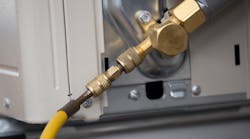Latest from Eatherton
Sponsored
A while back, I addressed the energy savings potentials behind a drain waste heat recovery heat exchanger. It has the potential of reducing energy consumption of residential applications by as much as 50 percent. That’s a huge reduction in the energy associated with the heating of domestic hot water. There is another method of heat recovery typically associated with commercial restaurant operations, that method being refrigerant waste heat recovery. Each ton of refrigeration moves roughly 12,000 Btu’s of energy per hour either out of a cooled walk in refrigeration unit or air conditioning system.
The great thing about this type of system is that the availability of recovered energy matches the demand for energy to heat hot water for cleaning dishes and equipment. This means that the required storage is rather small, in fact may be nonexistent in some cases. There are refrigerant heat recovery systems that only recover the de-super heat energy of the refrigeration process. That is the highest temperature gasses typically coming off of the refrigerant compressor. There are also some larger units that are considered a full condensing type of recovery unit.
Although there is a big difference in initial cost between a de-super heater recovery unit versus a full condensing unit, the amounts of energy that they recover is also fairly significant. De-super heating recovers roughly 25 percent of the captured energy available. In some cases, the use of a refrigeration to water heat exchanger can increase the operating efficiency of a given refrigerant package which is also represents significant dollar savings.
As I previously mentioned, if all you are doing is recovering the de-super heating portion of a given refrigerant cycle, then a pre-heat storage tank is probably not necessary. If you are doing a full condensing recovery, then the additional storage may be necessary and will ensure the efficient recovery of refrigerant heat and the efficient operation of the refrigerant equipment. The temperature of availability is directly proportional to the refrigerants in use, but storage tank temperatures in the range of 140°F are not unheard of. This may require the use of an anti-scald mixing valve on either the pre-heat storage tank or possibly the auxiliary tank outlet.
Other potential applications of this “free” energy are the heating of swimming pools or hot tubs, frost control in large commercial freezers, snow and or ice melt, space heating and pretty much anywhere that there is a need for hot water around 120°F to 140°F. Caution is urged to the installers of these systems to make certain that compressor warranties are not affected by the application of aftermarket equipment. Most refrigerant equipment manufacturers may offer their own version of a waste heat recovery package that is compatible with their equipment. Some systems consist of a tank wrapped by a stainless steel heat exchanger. The exchanger is in good contact with the tank surface, allowing a great energy transfer rate. The ideal situation is to find a load that will exceed the capacity of the connected refrigerant cooling system. That way, there will never be any thermal energy rejected to the outside.
In some types of systems there will be a centrally located storage tank with a heat exchanger. There may be a drain back storage tank configured, such that when there is no cooling going on and no waste heat to be recovered, the heat transfer fluid will drain back into the heat of the house, similar to a drain back solar thermal system. As added protection, the heat transfer fluid may be a non-toxic glycol, similar to the type used on snow and ice melting systems. Each cooling unit would have a dedicated pump, sized based on the desired (requires) flow rates and the required head pressure to get the heat transfer fluid up to the roof mounted heat exchanger, and establish a siphon on the downcomer going back to the centrally located pre-heat storage tank.
Regardless of the application, these systems work best where loading and demand are matched. One particular area of application that has been proven to be extremely successful is the food service industry, especially sit down restaurants. The customers bring with them 500 Btu’s per hour of thermal energy that has to be rejected, and they are also eating off of dishes that will require cleaning using service hot water. Unfortunately, most restaurant physical plants have a very small footprint and no space available for a pre heat storage tank, so those situations may require that de-super heating applications only.
One company that I have had the opportunity to work with is Swing Green. They carry a device called the Pool Fox. They are made of materials that make it impervious to the corrosive tendencies of swimming pool water. More information can be obtained by visiting Swing Green’s website. The other device they have is called an Air Fox for connection to air conditioning systems.
Mark Eatherton material on this website is protected by Copyright 2017. Any reuse of this material (print or electronic) must first have the expressed written permission of Mark Eatherton and CONTRACTOR Magazine. Please contact via email at: [email protected].
Mark Eatherton
Mark Eatherton material on this website is protected by Copyright 2017. Any reuse of this material (print or electronic) must first have the expressed written permission of Mark Eatherton and CONTRACTOR Magazine.


